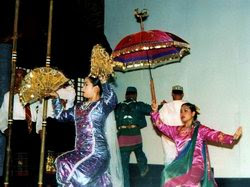
videocredit: Masterscribble
Also known as the Princess Dance or the Royal Maranao Fan Dance, the dance is based on the Maranao interpretation of the ancient Indian epic, the Ramayana: the Darangen. The Singkil narrates a scene in which Sita (Putri Gandingan) escapes her abductor, the demon king Ravana and is lost in the forests of Alangka, thereupon being found by her husband, Prince Rama. Interesting to note is that in the original Ramayana epic, Rama selects Hanuman, the Hindu monkey-god, to find Sita on his behalf; the fact that in the Singkil it is Rama (Rajah Bantugan) who finds her suggests a modification of the original Hindu narration in order to agree with monotheistic Islamic ideology.
Kasingkil refers to the art of moving one’s feet in and out of two clicking bamboo poles in imitation of Putri Gandingan who gracefully avoided the falling trees brought about by an earthquake.
Performers would therefore gracefully step in and out of bamboo poles, arranged in crisscross fashion while manipulating either fans or simply their bare hands.Played at celebrations and festivals, traditionally the dance was performed by a girl of royal blood intend on advertising herself to would-be-suitors for her future marriage.
The dance is said to have been named after either the leg bracelets or anklets of silver, nickel or brass with chiming bells of the same name or the act of voluntarily or accidentally entangling on one’s feet in either vines or tall grass.
source: Wikipedia
Technorati tags:
Philippine Folk Dance,tinikling,singkil,itik,binasuan,pandango sa ilaw,sayaw sa bangko,carinosa,kalapati,Types of Philippine Folk Dances,Filipino Folk Dance






















No comments:
Post a Comment